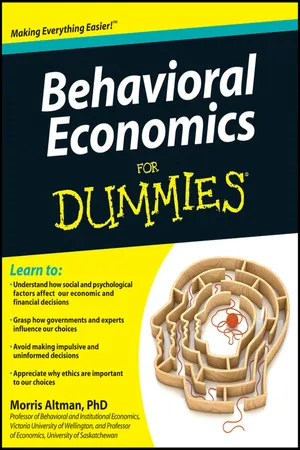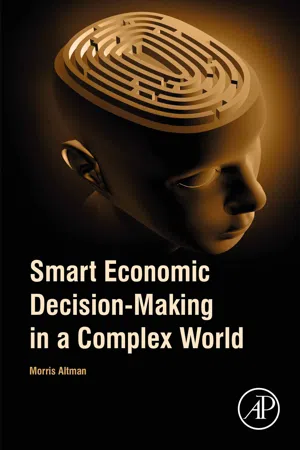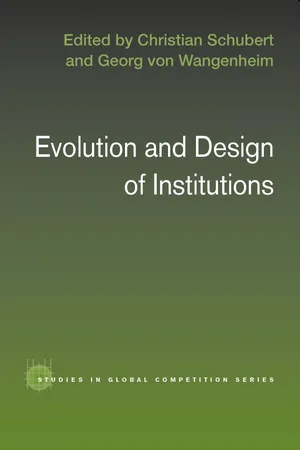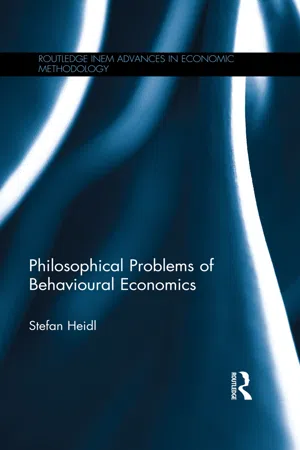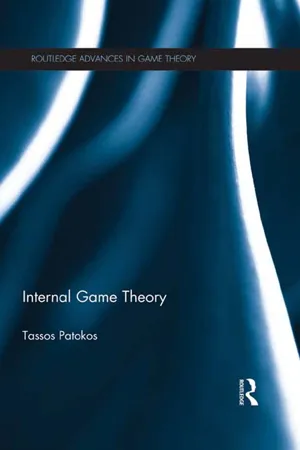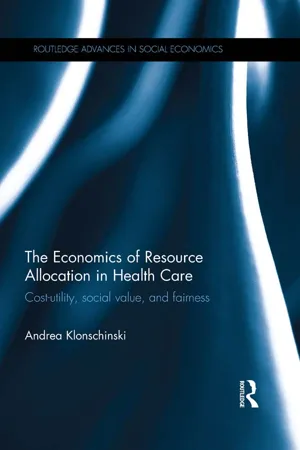Economics
Revealed Preference
Revealed preference is a theory that suggests that people's preferences can be inferred from their choices. It assumes that people make rational decisions based on their preferences and constraints. This theory is widely used in economics to understand consumer behavior and market demand.
Written by Perlego with AI-assistance
Related key terms
Related key terms
1 of 4
Related key terms
1 of 3
8 Key excerpts on "Revealed Preference"
- eBook - ePub
- Morris Altman(Author)
- 2012(Publication Date)
- For Dummies(Publisher)
But behavioral economists, including Thaler and Sustein, don’t simply emphasize biased behavior; they also pay considerable attention to decision-making errors based on false or misleading information. Also of importance is people’s lack of power to make the choices they most prefer. In this case, an individual’s freedom to choose remains of fundamental importance. Factors outside a person’s control are identified as impeding him from making decisions that are in his best interest.Revealed Preferences: When Choices Reveal Your Inner SelfRevealed Preference theory in economics is pretty simple: Your choices reveal your preferences — in other words, what you actually want. You wouldn’t buy what you don’t want. And what you buy is what you want. Otherwise, why would you spend your hard-earned cash? According to this perspective, what you choose is always what you want.Revealed Preference theory was pioneered by Paul Samuelson of the Massachusetts Institute of Technology (MIT). It was an attempt to provide meat to a very abstract theory of consumer behavior. But it’s definitely rooted in the assumption that people’s choices express their preferences and that their preferences, when translated into choices, reflect what’s in their own best interest. Their choices, which reveal their preferences, reflect their efforts to maximize their well-being given their income and relative prices.If these assumptions hold true, then it follows that you can make use of the Revealed Preferences to measure the well-being achieved by all members of society. When income and relative prices change, people respond to these changes by adjusting their choices given their established preferences for goods and services. These adjusted choices still represent their Revealed Preferences — and these choices still serve to maximize their well-being.The narrative about preferencesThe standard way in which the narrative about preferences is told takes the form of indifference curve analysis, with an interplay between budget constraints and relative price curves (see Figure 5-1). The budget line tells how much people can purchase with their income. The slope of the budget line reveals the relative price of two products, such as apples and pears. The indifference curve is an imaginary construct (part of the economics theoretical toolkit) that indicates a given level of well-being or utility - eBook - ePub
Preference Data for Environmental Valuation
Combining Revealed and Stated Approaches
- John Whitehead, Tim Haab, Ju-Chin Huang(Authors)
- 2012(Publication Date)
- Routledge(Publisher)
et al. (1996) assessed a large number of studies, and demonstrated that the tendency was for Revealed Preference values to exceed stated preference values. In these cases, the maintained hypothesis was that Revealed Preference approaches provided valid measures of welfare, against which stated preferences could be tested.Much has changed since economists began comparing results of the two approaches to valuation. We have a much clearer idea of the strengths and weaknesses of each approach and most researchers view each approach as advantageous in the appropriate setting. For Revealed Preferences, there is no apparent incentive problem. It is in the agent’s best interest to minimize the costs of obtaining a given level of well-being, which is the behavioral assumption of Revealed Preferences—all commodities and services are chosen optimally. In practice, recovery of values from observations on behavior runs into two kinds of problems: non-optimizing behavior that provides the basis for behavioral economics2 and econometric problems. For the most part, the assumption of optimizing behavior for Revealed Preference activities seems relatively innocuous, with the possible exception of housing purchases. Econometric problems are not so easily dismissed. A variety of econometric issues, from measurement errors in data to unobserved individual heterogeneity, plague the estimation of structural models that lead to valuation. Intensive efforts to eliminate unobserved individual heterogeneity have led to models with practically no focus on behavior, such as the housing study of Chay and Greenstone (2005) (which given its use of subjective assessment of housing values, might as easily be described as stated preferences). Some problems, such as the value of travel time in various travel cost models, have a considerable impact on valuation but remain stubbornly resistant to satisfying solutions. Anyone dissatisfied with a welfare measure from a travel cost model can make a new assumption about the value of travel time to obtain another result. Consequently, while new models such as the generalized corner solution model Phaneuf et al. - eBook - ePub
- Ken Binmore(Author)
- 2008(Publication Date)
- Princeton University Press(Publisher)
utility as a measure of the pleasure or pain a person feels as a result of a decision being made. Perhaps he thought that some kind of metering device might eventually be wired into Pandora’s brain that would show how many units of utility (utils) she was experiencing. This is a less bold hypothesis than it may once have seemed, since we now know that rats will pull a lever that activates an electrode embedded in a pleasure center in their brains in preference to anything else whatever—including sex and food. It is therefore unsurprising that a modern school of behavioral economists have reverted to this classical understanding of the nature of utility. A more specialized group devote their attention specifically to what they call happiness studies. However, the theory of Revealed Preference remains the orthodoxy in economic theory (Mas-Collel et al. 1995).1.5.1 Freeing Economics from Psychology
Economists after Bentham became increasingly uncomfortable, not only with the naive hypothesis that our brains are machines for generating utility, but with all attempts to base economics on psychological foundations. The theory of Revealed Preference therefore makes a virtue of assuming nothing whatever about the psychological causes of our choice behavior.This doesn’t mean that economists believe that our choice behavior isn’t caused by what goes on in our heads. Adopting the theory of Revealed Preference doesn’t entail abandoning the principle that reason is the slave of the passions. Studies of brain-damaged people show that when our capacity for emotional response is impaired, we also lose our capacity to make coherent decisions (Damasio 1994). Nor is there any suggestion that we all make decisions in the same way. The theory of Revealed Preference accepts that some people are clever, and others are stupid; that some care only about money, and others just want to stay out of jail. Nor does the theory insist that people are selfish, as its critics mischievously maintain. It has no difficulty in modeling the kind of saintly folk who would sell the shirt off their back rather than see a baby cry. - Morris Altman(Author)
- 2020(Publication Date)
- Academic Press(Publisher)
In contrast with the conventional perspective on choice behaviour, a model of preference formation is developed of rational or intelligent utility maximizing agents wherein they can possess preferences that are objectively suboptimal from both an individual and social perspective. In other words, one should not assume consumer sovereignty as a given. In addition, the Revealed Preferences of agents might be optimal from the perspective of the individual agents, but might conflict with the preferences of other agents. With optimal but heterogeneous preferences, based on issues of gender or class, for example, moral and political dilemmas might arise with respect to resolving such optimal but conflicting preferences. Thus, the Revealed Preferences of agents cannot be deemed, necessarily, as an indicator of what is in the best interest of the agent and of society at large. For optimal preferences to be constructed and chosen requires an appropriate institutional setting. Moreover, the extent to which preferences are optimal affects the relative efficiency of the economy. Understanding how optimal preferences are constructed and realized is thus critically important from an analytical and from both an individual and social welfare perspective.Keywords
Freedom of choice; Consumer sovereignty; Revealed Preferences; Sub-optimality; Institutional design; Decision-making environment; Externalities; Conflicting preferencesChapter outline- Introduction
- An alternative model of preference formation
- Conventional perspectives and critiques
- Constructing an alternative theory of welfare maximization
- Choice x-inefficiency and x-inefficiency in production
- Conclusion
- References
Introduction
It is important to model choice behaviour in a manner that captures the reality that choices made by individuals are often not utility maximizing or satisficing from the perspective of the person doing the choosing. If an individual’s choice behaviour is not welfare maximizing, as it is always assumed to be in the traditional economics narrative, then the Revealed Preferences of individuals need not be a metric for the good life. Rather, choice behaviour might instead reflect the preferences of others, misleading or incomplete information, or poor education. A key point made in this chapter is that only in an environment where individuals are free to choose and have effective voice, irrespective of income, gender, ethnicity, or religion, can choice behaviour be a metric for the good life. It is possible for rational agents who are characterized by optimal or true preferences to be unable to realize or manifest these preferences for social or institutional reasons. This has important implications for economic theory as well as for public policy, especially for institutional design. The perspective adopted in this chapter also explicitly takes the ethical and normative stance that one should respect the free choices of individuals and that free choice is an important component of the good life or socio-economic wellbeing (Sen, 2009 ). The narrative model builds on insights from Berlin (1968) , Harsanyi (1982) , Nussbaum (1999 , 2000) , and Sen (1990 , 1999 , 2000 , 2009) , amongst others, who argue that the manner in which preferences are formed and expressed is important for understanding the welfare implications of expressed preferences and the choices made by individuals. Insights of contemporary behavioural economics, which find that the manner in which choices are framed impact on the choices individuals make, need to be considered as well (Thaler & Sunstein, 2003 , 2008 ; Tversky & Kahneman, 1981- eBook - ePub
- Christian Schubert, Georg Von Wangenheim(Authors)
- 2006(Publication Date)
- Routledge(Publisher)
Yet economics traditionally assumes that preferences are constant. This “unrealistic” assumption allowed economists to make great progress in explaining human behavior and in deducing relevant policy consequences. Taking preferences to be immutable focuses the analysis on the effect of (generalized) relative price changes (or changes in the opportunity set) on behavior. This approach has been most clearly visible in the work by Gary Becker (1962, 1976). To the surprise, and also the dismay, of many social scientists (including some economists), he demonstrated that the approach holding preferences constant provides valuable insights not only in the area of the economy, but far beyond. This success led to the claim of economics being the “Queen of the Social Sciences” (most prominently Stigler 1984, Lazear 2000).At the same time, there were always economists who wanted to deal with changing preferences. There is a long intellectual history of attempts to explain changes in human preferences. But this approach has met with little success. Changing preferences play a minor role in economics. While quite a number of such efforts were undertaken in the 1970s and 1980s,2 today there are but a few publications addressing this issue, at least in the leading journals. Economics, as revealed in advanced level textbooks, has essentially disregarded these attempts.A different, and more successful, route explains changes in tastes by assuming the utility function to be time invariant and equal between individuals, but that individuals accumulate human capital based on their past experiences (Stigler and Becker 1977, Becker 1996). A particular consumption bundle leads to a different evaluation by individuals, depending on the amounts of such human capital accumulated. Most people would consider such a process to be a change in preference. This avenue produced noteworthy and empirically testable insights into human behavior (e.g., Becker and Murphy 1988 on addiction). It also yielded important policy results, for instance that drug addicts can only get rid of their dependence if they decide to abstain abruptly and completely (“cold turkey”). The approach, however, found relatively few followers, perhaps because such redefinition in terms of a change in human capital is considered to be somewhat artificial. - eBook - ePub
- Stefan Heidl(Author)
- 2016(Publication Date)
- Routledge(Publisher)
Within behavioural economics there are different ideas about which type of change is necessary to solve the anomalies of the standard theory. The behavioural economic mainstream presupposes that modelling additional influences on the preferences of agents is enough and that revisionary changes of the theory are not necessary. They think that one can deidealise economic theory based on the results of behavioural decision research and still keep the preference concept and the same model of preference-based explanation. Whether this is actually the case is of course an empirical question but the discussion shows that the preference-based theory of choice has the capacity to integrate at least some results of behavioural decision research.2.3.2 Testing hypotheses about mentalistic preferences
A second worry about the mentalistic concept of preference is that employing mentalistic preferences in the formulation of economic hypotheses reduces the empirical content of economic theory because subjective mental states such as preferences are not directly observable (Grüne-Yanoff, 2004 : 382). Hypotheses about mental entities are thus thought to be without definitive observational consequences.Revealed Preference theory and its behaviouristic interpretation of preferences are seen as a way of guaranteeing the empirical respectability of economics because the behaviouristic interpretation allows for preferences to be inferred from observed behaviour (ibid.). The use of the behaviouristic preference concept is supposed to maximise the empirical content of economic theory by guaranteeing that to every theoretical statement a corresponding statement about observable choice behaviour exists.Based on these considerations, adherents of Revealed Preference theory such as Faruk Gul and Wolfgang Pesendorfer express a preference for theoretical hypotheses whose meaning is defined via the results of choice experiments. Gul and Pesendorfer consider it an advantage of their approach ‘that preferences over decision problems are at least in principle observable’ (Gul and Pesendorfer, 2005 - eBook - ePub
- Tassos Patokos(Author)
- 2013(Publication Date)
- Routledge(Publisher)
2 Individual behaviour2.1 Preferences and utilityIndividual choice theory is the foundation of mainstream economic theory. It is about how rational people make choices, and it extends well beyond consumers and markets, as it offers a framework that may be used to analyse the behaviour of any rational individual, whatever his or her possible alternative choices: it is not only about decisions on what quantities of goods to buy from the market at given prices and level of income (as might be the impression after reading a micro-economics textbook), but it also covers all kinds of possible decisions, and applies to any scenario where the individual has to choose from a set of alternatives. Because of this, it could be said that it is a remarkably ambitious theoretical programme, which essentially provides us with a general theory on human behaviour. Now, given that individuals commonly indulge in all sorts of behaviours, it is hardly surprising that the theory exclusively restricts its attention to a special class of individuals: the rational ones. This seems a necessary limitation, if we want the theory to have anything meaningful to say at all.The obvious first step for any theory seeking to analyse the behaviour of a rational individual is to give a precise definition of rationality. Economic theory, indeed, offers us not just one, but two such definitions. The most renowned one focuses on the preferences of the rational individual, while the second definition relies on the individual's actual choices. It will be instructive to delve into both of them, because, for one thing, they are linked with each other, and secondly, because there is much to be said about the fact that the preference-based definition of rationality is most common, while the choice-based approach is not used very often.The definition of rationality that uses preferences requires that the rational individual's preferences have two properties: completeness and transitivity - Andrea Klonschinski(Author)
- 2016(Publication Date)
- Routledge(Publisher)
underlying stable preference scale (see Mongin/D’Aspremont 1999: 383), as the following quote from Hicks (1959: 17) illustrates:What I mean by action according to a scale of preference is the following. The ideal consumer […] chooses that alternative, out of the various alternatives open to him, which he most prefers, or ranks most highly. In one set of market conditions, he makes one choice, in others other choices; but they must always express the same ordering , and must therefore be consistent with one another.This is a very important condition and quite severe at that, as will become clear in the analysis of prioritization preferences below.The quoted passage exposes a further characteristic of the economic preference concept: as the previous considerations of the history of economics already illustrated, the preference concept is intimately connected with choices. To assume that choices “express” preferences implies vice versa that preferences, together with beliefs and constraints, determine choices (see Mongin/D’Aspremont 1999: 383). This requirement of “choice determination” has an important implication, for if preference orderings are to determine choices, they need to take into account everything relevant to that choice so that preferences have to be preferences all things considered (Hausman 2012: 15, 17). This claim can be illustrated by contrasting the economic preference concept with the use of the preference notion in the vernacular. In ordinary parlance, the term preference is often considered to denote an egoistic, self-interested desire (see Hausman 2012: 65). It is thus possible that although a person actually prefers x to y , she chooses y out of, say, a sense of duty. In this case, the narrowly conceived preference ranking does not determine the choice and, put the other way round, the chosen alternative does not allow for inferring anything about the agent’s preferences. Hence, if preferences are to determine choices, any factor influencing choices must do so via influencing preferences, which “is another way of saying that preferences must be total comparative evaluations” (Hausman 2011: 10).132
Index pages curate the most relevant extracts from our library of academic textbooks. They’ve been created using an in-house natural language model (NLM), each adding context and meaning to key research topics.
Explore more topic indexes
Explore more topic indexes
1 of 6
Explore more topic indexes
1 of 4
